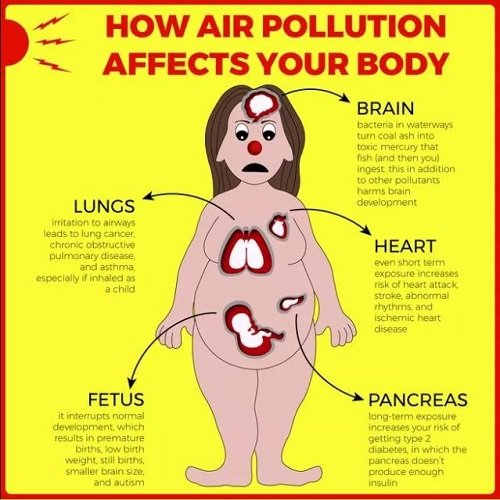Air Pollution Can Directly Impact The Brain
Introduction
Few days ago in California, wildfires started raging through the south. Diana Younan, studying environmental health at the Keck School of Medicine at the University of Southern California, warned members of her family living around the smoke affected areas to stay indoors as much as possible.
Tiny particles from high air pollution levels from fire outbreak, cause a lot of damage to our body system, and Diana Younan knew that, hence the warning to her family members.
Diana Younan said;
“It is very well known that air pollution can affect respiratory function or health. But it’s not as well known that it can also affect the brain.”

Air pollution linked to brain problems
Scientists over the last decade have noticed increasing evidence to show that inhaling polluted air can have toxic effect on the brain.
Studies are beginning to show that this toxicity of air pollution is slowly being linked to particular children and adolescent behaviours.
According to Diana Younan, the link between air pollution and behaviours is similar to the effect that lead – which is used for paint and gas – has on children who get exposed to it.
Some scientists now think that the decline in the rate of crime in the most nations, including the U.S. since the 90’s, is connected to the removal of lead from gasoline production.
Diana Younan says;
“Lead is what pioneered the whole research on environmental risk factors.”
Analysis and Research
A study of nearly 700 chidren, revealed to Younan and her research team that children in Los Angeles who had been exposed to high level of air pollution during their adolescence were more likely to involve themselves in delinquent behaviours.
The research was published on Wednesday, 13th of December in the Journal of Abnormal Psychology. The research also found that when kids had a mother exhibiting signs of depression or when the kids have bad relationships with their parents, the same amount of exposure to pollution had a stronger effect on behavior.
The research study involved data that was gathered for almost a decade from children, beginning from when they were nine-years-old.
Questionnaires were passed across to parents every few years to complete questions on things such as ‘lying’, ‘vandalism’, ‘substance use’, and ‘cheating’, in their children.
The data obtained was then used by the research team to correlate data on daily measure of pollution in the child’s area to classify the amount of pollution, during the course of the research, which each child was exposed to.
Pollution from ‘particulate matter 2.5’ was specifically studied by Diana Younan, because they are tiny particles that are about 30 times smaller than a strand of human hair. She stated that;
“It’s not smog that people can see.”
“But if they can’t see it, it’s bad. This type of pollution primarily comes from cars and traffic.”

Connection between pollution levels and delinquent behaviours
Factors such as difference in race, gender, socio-economic status or other social factors couldn’t be used to explain the connection between delinquent behaviours and pollution levels. This underscored the study of the particulate matter as the driving effect from the research.
It was however noted that poorer families were more likely to live around polluted areas or near highway, and have a higher level of exposure to the particulate matter which causes the adverse effects.
Weaknesses from Younan’s research
Diana Younan identified some weaknesses in her study. She pointed out the fact that noise pollution was not taken into account. She also highlighted the fact that parent were able to give data and report of their child’s behavior at home alone. Parents were unable to account for their child’s behaviour at school or during social activities.
She however pointed out that it was a new area of research and she hopes that further studies would help validate the findings.
Related studies
A professor of Environmental Medicine at the University of Rochester, Deborah Cory-Slechta, started her career by studying lead exposure. She wasn’t part of the new study. But she has moved on to air pollution research in the past couple of years.
Deborah Cory-Slechta was skeptical that pollution could impact the brain, at the beginning.
“But it was amazing what we started to find,” Cory-Slechta says. “Everyone has been surprised, to say the least, at how dramatic some of these effects can be.”
Cory-Slechta focuses her studies on the effect of air pollution on animal models. From her studies she says that the changes in behavior seem to match the type of delinquent behavior reported in Diana Younan’s study.
“Even at relatively low levels of exposure [in animals], we see changes in behavior,” Cory-Slechta says. “Things like impulsivity, which can relate to delinquent behavior.”
Ways pollution can get to the brain
There are a couple of pathways through which pollution can get to the brain.
- Particles of pollutants inhaled into the lungs can find their way into the blood, and eventually circulate to the brain.
- Particulate matter can cause stress in the lungs, and this can lead to the production of inflammatory molecules which can then get to the brain.
- The nose is connected to a part of the brain called the olfactory bulb. When people inhale polluted air through their noses, pollution can also affect the brain directly.
According to Cory-Slechta, these paths then signify that particles skip past the protection that is normally offered by the blood-brain barrier.
Conclusion
The research and study of air pollution and its connection to the brain have thrived in the last few years. Based on research by Diana Younan and Cory-Slechta, there’s a whole lot of work still to be done in the field; as it is still a new area of study.
Particulate matter is mostly accompanied by organic matter, metals and other containments; which possess the capability of wreaking havoc on the brain, especially during the critical developmental stages of a child.
The behavioural effects are physical responses to pollution, and it damages the brain, according to Diana Younan.
She further stated that when the lead compound was removed from gas, the rate of crime dropped. Younan thinks that it might be the result of the air pollution as well
References: r1, r2, r3, r4, r5